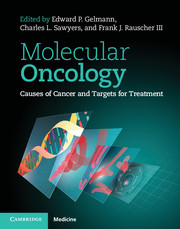Book contents
- Frontmatter
- Dedication
- Contents
- List of Contributors
- Preface
- Part 1.1 Analytical techniques: analysis of DNA
- Part 1.2 Analytical techniques: analysis of RNA
- Part 2.1 Molecular pathways underlying carcinogenesis: signal transduction
- Part 2.2 Molecular pathways underlying carcinogenesis: apoptosis
- Part 2.3 Molecular pathways underlying carcinogenesis: nuclear receptors
- Part 2.4 Molecular pathways underlying carcinogenesis: DNA repair
- 34 The ATM-mediated DNA-damage response
- 35 Werner syndrome: association of premature aging and cancer predisposition
- 36 Hereditary disorders of DNA repair and DNA damage tolerance that predispose to neoplastic transformation
- 37 Telomerase: target for cancer treatment
- Part 2.5 Molecular pathways underlying carcinogenesis: cell cycle
- Part 2.6 Molecular pathways underlying carcinogenesis: other pathways
- Part 3.1 Molecular pathology: carcinomas
- Part 3.2 Molecular pathology: cancers of the nervous system
- Part 3.3 Molecular pathology: cancers of the skin
- Part 3.4 Molecular pathology: endocrine cancers
- Part 3.5 Molecular pathology: adult sarcomas
- Part 3.6 Molecular pathology: lymphoma and leukemia
- Part 3.7 Molecular pathology: pediatric solid tumors
- Part 4 Pharmacologic targeting of oncogenic pathways
- Index
- References
35 - Werner syndrome: association of premature aging and cancer predisposition
from Part 2.4 - Molecular pathways underlying carcinogenesis: DNA repair
Published online by Cambridge University Press: 05 February 2015
- Frontmatter
- Dedication
- Contents
- List of Contributors
- Preface
- Part 1.1 Analytical techniques: analysis of DNA
- Part 1.2 Analytical techniques: analysis of RNA
- Part 2.1 Molecular pathways underlying carcinogenesis: signal transduction
- Part 2.2 Molecular pathways underlying carcinogenesis: apoptosis
- Part 2.3 Molecular pathways underlying carcinogenesis: nuclear receptors
- Part 2.4 Molecular pathways underlying carcinogenesis: DNA repair
- 34 The ATM-mediated DNA-damage response
- 35 Werner syndrome: association of premature aging and cancer predisposition
- 36 Hereditary disorders of DNA repair and DNA damage tolerance that predispose to neoplastic transformation
- 37 Telomerase: target for cancer treatment
- Part 2.5 Molecular pathways underlying carcinogenesis: cell cycle
- Part 2.6 Molecular pathways underlying carcinogenesis: other pathways
- Part 3.1 Molecular pathology: carcinomas
- Part 3.2 Molecular pathology: cancers of the nervous system
- Part 3.3 Molecular pathology: cancers of the skin
- Part 3.4 Molecular pathology: endocrine cancers
- Part 3.5 Molecular pathology: adult sarcomas
- Part 3.6 Molecular pathology: lymphoma and leukemia
- Part 3.7 Molecular pathology: pediatric solid tumors
- Part 4 Pharmacologic targeting of oncogenic pathways
- Index
- References
Summary
Introduction
Werner syndrome (WS) is a rare autosomal recessive disorder in humans characterized by segmental premature aging. Somatic cells from WS individuals show low replicative capacity, hypersensitivity to DNA-damaging agents, increased genome instability, and altered telomere maintenance (1). The incidence of sarcomas is significantly higher in WS patients than in normal individuals (1). Genetic evidence indicates that WS is caused by loss of function mutations in the WRN gene, which encodes a protein that belongs to the RecQ family of DNA helicases. Polymorphisms in WRN have been demonstrated to be associated with breast cancer (2) and soft tissue sarcomas (3,4). The WRN gene has been cloned and the properties of WS cells and WRN protein have been studied extensively. Nevertheless, the pathophysiology of WS and the cellular and molecular mechanisms involved in WS pathogenesis remain poorly understood. Because WS is a progerioid disease, it is used as a model system to better understand the process of aging in humans.
The exact biological role of WRN remains unknown. However, it has been proposed that it plays roles in the response to DNA damage. In particular, WRN may promote rescue of stalled replication forks and help resolve recombination intermediates in cells experiencing replicative stress. WRN also plays a role in telomere replication and alternative lengthening of telomeres. Thus, loss of function mutations in WRN could disrupt DNA replication and DNA-damage processing, resulting in accumulation of DNA double-strand breaks (DSBs) and recombination intermediates. These events could activate cell-cycle checkpoints resulting in senescence, apoptosis, or genetic instability leading to cellular transformation. These molecular endpoints could ultimately lead to features of premature aging and/or increased cancer susceptibility (Figure 35.1). This chapter discusses how WRN may contribute to genome stability and reduce cancer susceptibility.
- Type
- Chapter
- Information
- Molecular OncologyCauses of Cancer and Targets for Treatment, pp. 423 - 433Publisher: Cambridge University PressPrint publication year: 2013

